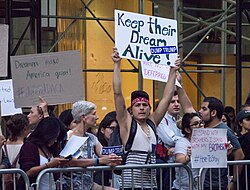Deferred Action for Childhood Arrivals
The Deferred Action for Childhood Arrivals (DACA) was an American immigration policy that allowed some individuals who entered the country as minors, and had either entered or remained in the country illegally, to receive a renewable two-year period of deferred action from deportation and to be eligible for a work permit.
As of 2017, about 800,000 individuals—referred to as Dreamers after the DREAM Act bill—were enrolled in the program created by DACA. The policy was established by the Obama Administration in June 2012 and rescinded by the Trump Administration in September 2017.[1] In November 2014 President Barack Obama announced his intention to expand DACA to cover additional illegal immigrants. But multiple states immediately sued to prevent the expansion, which was ultimately blocked by the courts.
Deferred Action For Childhood Arrivals Media
A Form I-797 Notice of Action issued by United States Citizenship and Immigration Services indicating that the addressee has been granted deferred action under the DACA program
A Form I-512L issued by USCIS in 2014, permitting a U.S. Customs and Border Protection officer to allow the named DACA recipient to enter the United States under the parole authority in the Immigration and Nationality Act.
A stamp applied to the Mexican passport of a DACA recipient entering the United States with Advance Parole at John F. Kennedy International Airport in January 2017, with handwritten annotations indicating the passport holder was paroled into the United States by a Customs and Border Protection officer.
References
- ↑ Duke, Elaine (September 5, 2017). "Memorandum on Rescission Of Deferred Action For Childhood Arrivals (DACA)". United States Department of Homeland Security.




